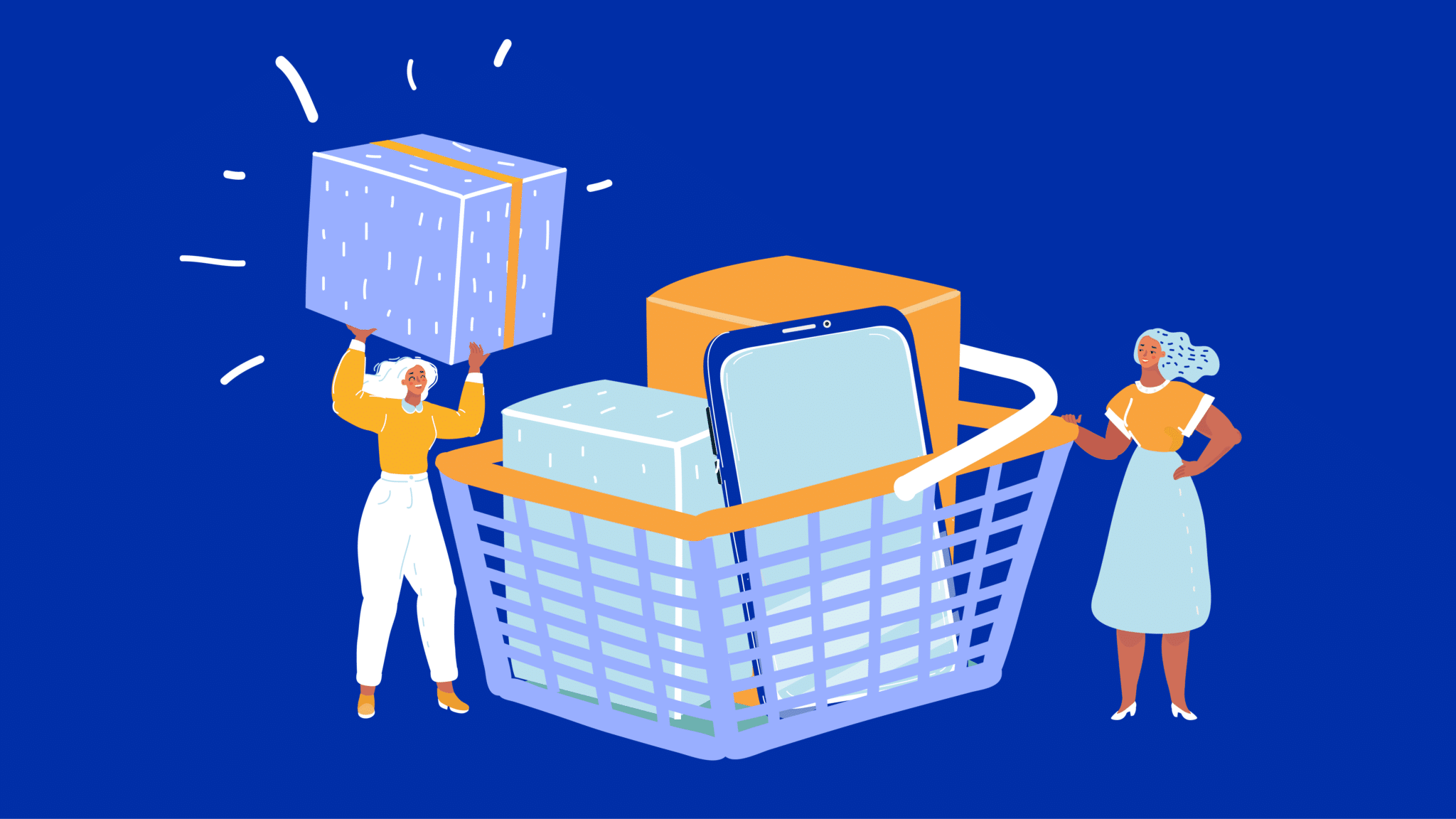Maya Angelou once said that people will never forget how you made them feel, and that idea is at the heart of creating a great ecommerce customer experience. In a crowded ecommerce market, everyone has products to sell, and when viewed through a digital screen, they all seem very similar, so brands have to stand out if they want to build customer loyalty. One place companies can always compete is in the experience they provide to their customers.
“If you do build a great experience, customers tell each other about that. Word of mouth is very powerful.”- Jeff Bezos
As more people use online shopping, the ecommerce customer experience is becoming an essential part of every successful business strategy. Shoppers want a stress-free shopping experience, and businesses that provide that are already ahead of the pack. To earn the loyalty of customers and have them tell their friends about your great products, you need to create a user-centered site that will make customers remember how good you made them feel.
What Is an Ecommerce Customer Experience?
The customer experience encompasses all of a person’s interactions with a business. If their interactions are positive, they’ll come back, speak positively about the brand, and recommend it to friends. If their interactions are negative, none of that will happen. It’s far more likely they’ll go to a competitor and steer people toward a different site.
From an online standpoint, the customer’s ecommerce experiences refer to all the digital interactions a shopper has with your brand as they make a buying decision. The most obvious place for digital experiences is the business website, but social media platforms and email interactions should also be considered.
Negative customer experiences don’t have to be objectively bad to scare customers away. A rude customer support representative or a sales page that fails to process a payment can make people think twice about purchasing. Confusing page designs, outdated graphics, or slow load times might also leave a bad impression.
Conversely, giving customers a good experience in ecommerce is easier than you might think. Start by being customer-focused when you design your online presence. Make their experience easy, enjoyable, and educational. Offer more than they expect — whether that’s free shipping, sample packs, or excellent content.
Finally, provide great service while letting your personality shine through in your branding and customer interactions.
Why Does Customer Experience Matter?
Research shows that customer experience drives revenue growth. A study by market research firm Forrester found that businesses that were leading in customer experience had a 17% growth rate from 2010-2015, while those who lagged behind only had 3% growth.
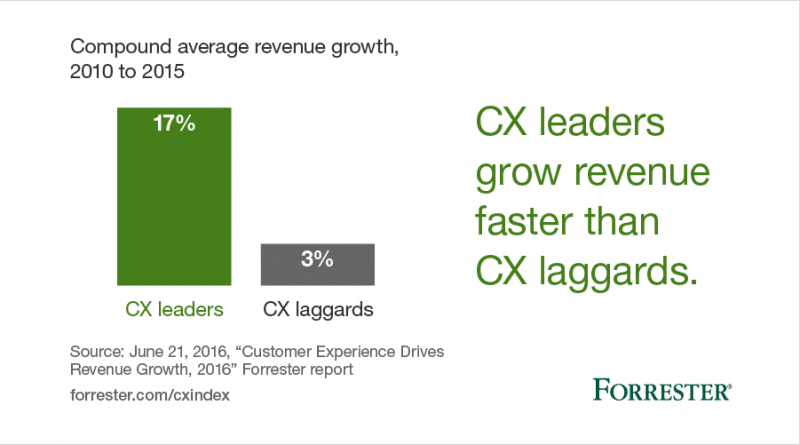
They also found that customers who have good experiences are more likely to keep doing business with the company and recommend it to others.
Customer retention is one of the keys to higher profits. It costs five times more to find new customers than to keep existing ones, and 66% of U.S. consumers spend more with brands they love. Focusing on the ecommerce customer experience can turn casual purchasers into loyal fans who will return time and time again.
Adding a Digital Component to Customer Experience
To be successful, ecommerce sites should focus their website design on the user’s experience. Without physical interaction, the web page must build a relationship with the customer, provide them with relevant information, and process the payment.
Research shows that buyers tend to judge ecommerce spaces more harshly than brick-and-mortar shops, as they perceive the company as being in full control of their website. For example, one study found that if a video takes more than 10 seconds to load, 50% of users will click away. Adapting to the digital world and user’s expectations of digital spaces is essential for ecommerce success.
Using digital solutions designed for an ecommerce marketplace can help to promote a positive online customer experience. Good design practices, regular upgrades, and site optimization can help fill the customer service gaps that may affect an ecommerce site. Technology also gives customers more features and services than they will ever find in a traditional store, including 24-hour shopping, reviews from other shoppers, and the ability to purchase immediately.
9 Tips to Enhance Your Store’s Digital Experience
Creating a good ecommerce customer experience takes time, but it doesn’t have to be difficult. Integrate ecommerce best practices into your customer service strategy, and remember that people buy from those they trust and know. Always show customers who you are, and put their experiences at the center of your design.
1. Make customer service accessible.
Although there are plenty of people who use an ecommerce site and never need to ask a question, there are always users who need a little help. They may have questions about a particular product, need help deciding between different options, or want information about the free shipping policy. These people should find those answers easily, or they might leave the page and never return.
In brick-and-mortar stores, it’s normal for a customer service representative to approach shoppers with the simple question, “How may I help you?” Chatbots allow you to give customers this experience in the digital world. A simple pop-up can be programmed to answer common questions and immediately show customers where they can go for help.
Of course, there are times when human interaction is needed, and live chat is a great option for directly answering questions. Customers like it because it allows them to get immediate answers rather than waiting for an email reply. Don’t forget to keep contact pages updated with email, phone numbers, and social media channels, and make sure you reply to every message received.
Look how chocolate company Bon Bon Bon lets their buyers know exactly how to reach them. The help menu is prominent on every page and links to an FAQ page.
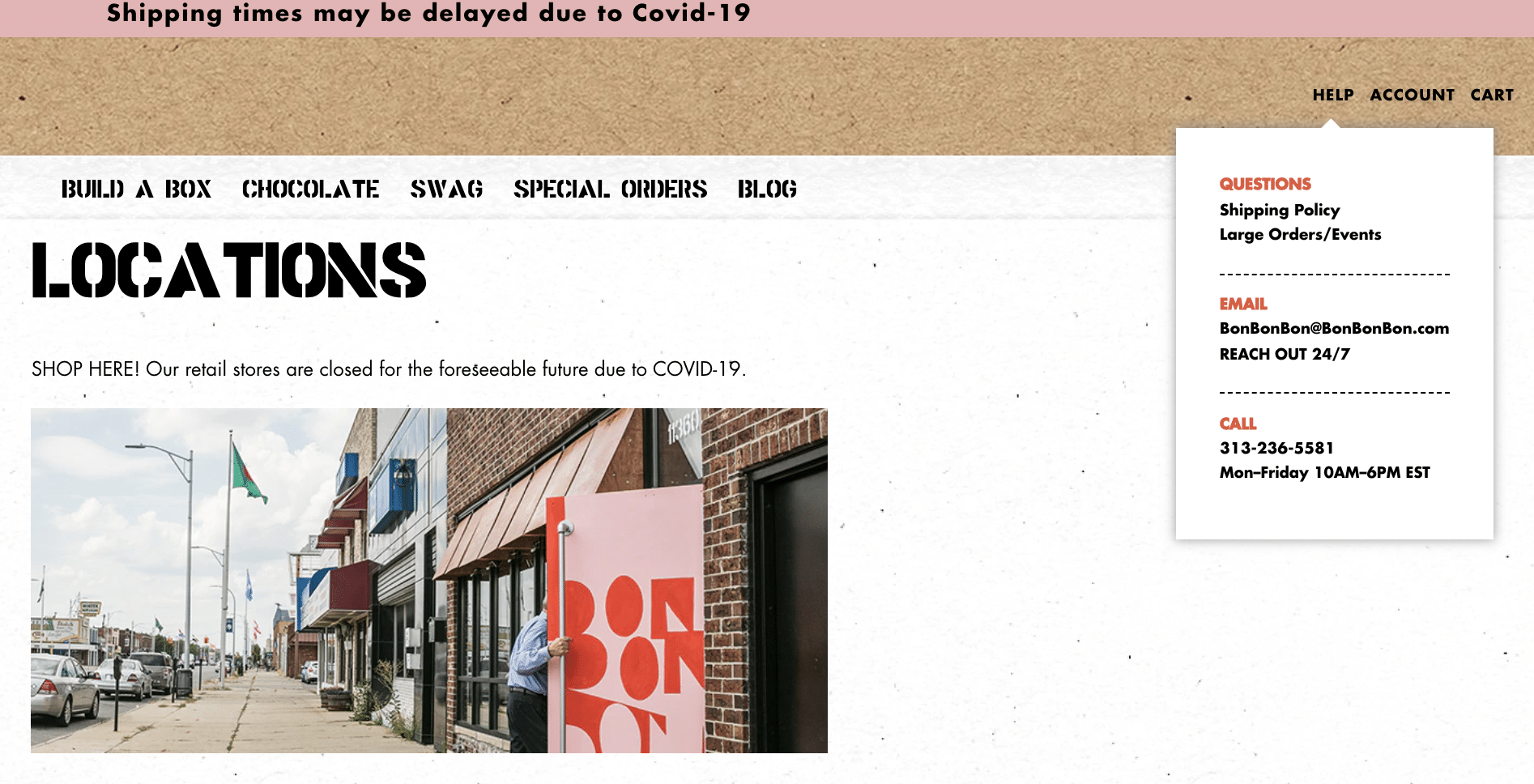
It also lists the company’s email address and phone number. On product pages, they clearly state what customers should do if they have a big order, namely, “Holla at us.”
2. Educate with high-quality content.
Research from Google shows that 53% of shoppers always do online research before they buy. Many people think about content marketing in terms of SEO rankings, but it can have a much bigger role. Businesses that give consumers the information they need are more likely to be seen as an authoritative source and will attract new customers who trust them to provide the best product.
Businesses should think beyond blogs when creating educational content: Videos, infographics, and podcasts are just some of the other options available. Think about who your customers are and how they digest information. Then, create content that will appeal to them. Post it on your website, social media, and places where your customers gather.
For a great example of educating customers, look no further than CBDistillery. Their ‘Learn More’ menu has a CBD 101 option, which gives customers a rundown on what CBD is, the benefits of using it, and an overview of the science. Then, it takes them through choosing the right product.
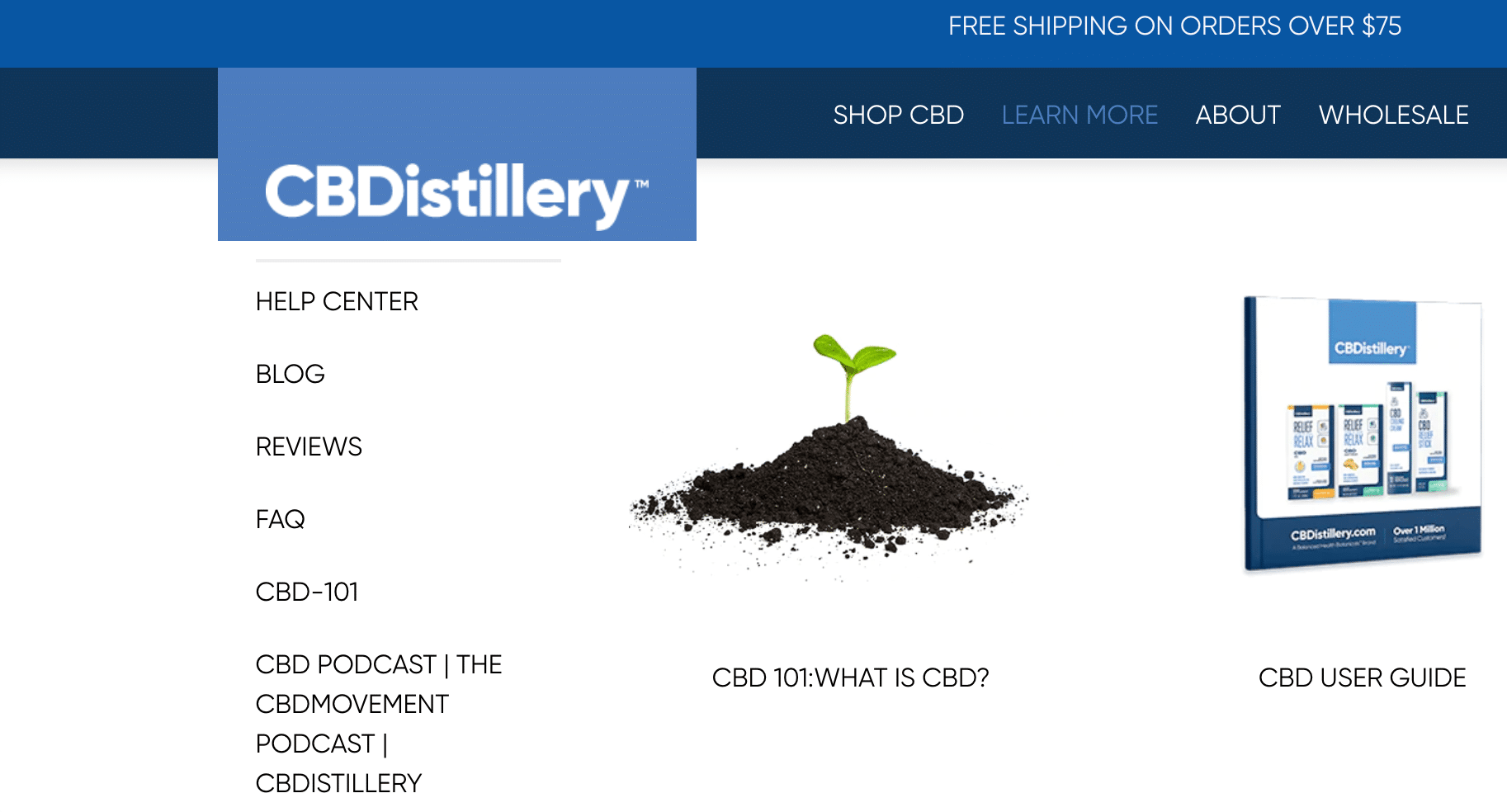
Their content doesn’t stop there. CBDistillery also has a podcast and blog for ongoing CBD discussion, and there’s an e-book, called The Ultimate CBD User Guide, that customers can have sent to them via email. The company is active on social media and uses those channels to educate the public about their industry.
With so much information available to their customers, CBDistillery sets themselves up as a leader in the industry and leaves customers feeling satisfied that they have made an informed decision.
3. Prioritize good overall design.
Your website’s design is perhaps the most important factor in the ecommerce customer experience. It sets the tone for your whole brand and helps establish the emotions you want to evoke in your customers. Most importantly, a well-designed website entices people to stay. If browsers click the back button because of an unattractive or confusing design, they won’t be spending any money.
The particulars of “good design” depend on your industry and brand, but there are elements that are considered web design best practices, starting with simplicity. If a website has too much information across the home page, it will confuse customers, and they’ll click away. Draw people in with striking graphics, but make sure they’re not so big that they lead to slow load times.
Finally, think about convenience, especially in the checkout process. Make it easy to see more details about a product and add that item to a shopping cart. Then, give them different payment options, especially through digital wallets. If your customer has to get off the couch to find a credit card in their purse, they may not bother and will either buy from a competitor or go without.
Water bottle manufacturer Larq has a website that captures all these elements of good design.
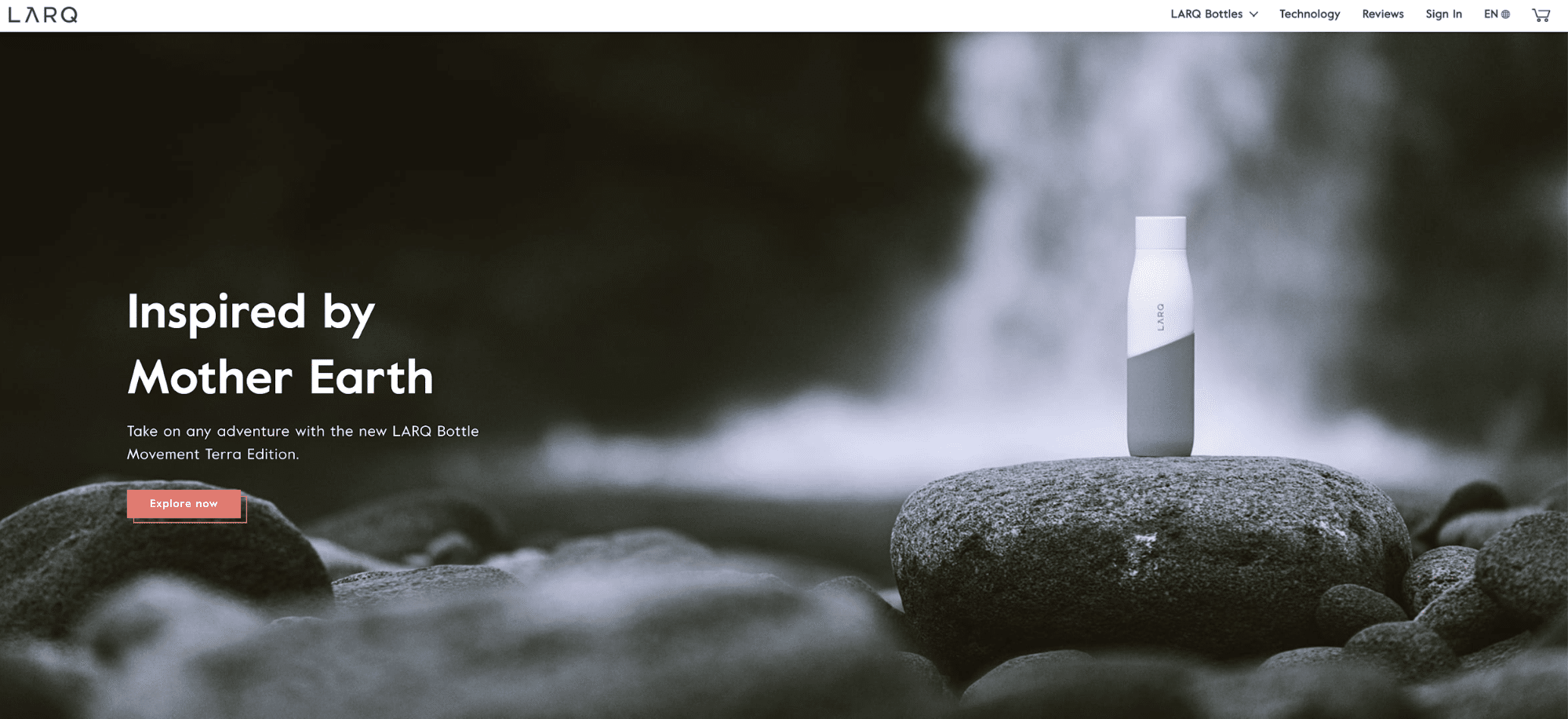
Its streamlined look reflects their brand identity, and the high-quality images show exactly what their product is and why you should purchase it. One click takes customers to their product page. The shopping cart is clear, and the checkout process is easy to complete.
4. Make personalized recommendations.
Everyone enjoys being remembered, whether it’s a barista who asks if you’d like your usual or a bookstore employee who points you towards the latest story by your favorite author. These are experiences that small brick-and-mortar stores do well but may seem difficult to replicate in the digital world.
It’s not impossible to personalize the ecommerce customer experience. The most obvious option is to use algorithms to make recommendations based on past purchases, which can be added as part of the checkout process. This may look like a linked video game on the bottom of the page or an email letting your customer know their favorite coffee is on sale.
With a little effort, there are other ways to treat customers like individuals. Of course, you should always be collecting customer email addresses to provide a receipt and delivery notification, but you can ask extra questions to get to know them. A birth date allows you to send a discount voucher at the right time, while a location can let customers know about a pop-up store or other event in their hometown.
You can also use these questions to segment your audience. If your product appeals to two types of customers, ask them where they fit to ensure that you provide relevant information that encourages them to complete the purchase.
For example, if you sell outdoor equipment, you can ask if they hike or drive to their camping spot. The hikers will appreciate information about lightweight equipment, while drivers may be interested in camping fridges or grills.
5. Products should be easy to find.
An easily navigable page is key if you’re trying to sell products in the digital space. Customers want to be able to find what they’re looking for and quickly make their purchase. Endless searches to find the right type of shoe will just frustrate them or drive them away.
A clear link to the product page is the minimum a home page needs. For some businesses, especially those that specialize in one or two products, this will be enough. Others need to think about how customers will find the needle they’re looking for among the haystack of other products.
It can be tempting to avoid filter or search options in the hope that customers will find something else to buy as they’re browsing. From the outside, this may seem like the candy at a supermarket checkout. However, at this point, customers are still looking at the signs and trying to find the right aisle; they’re not ready to commit.
Sorting products by category can help your customers get where they want to be. From there, filters do the hard work of narrowing the selection down. When customers find exactly what they’re looking for, they feel empowered to make a purchase. Once they’ve added something to the shopping cart, it’s time to offer accessories or let them know what other people have purchased because they’re finally ready to make those impulse buys.
Di Bruno Bros., a culinary store in Philadelphia, makes it easy for online customers to find exactly what they need.
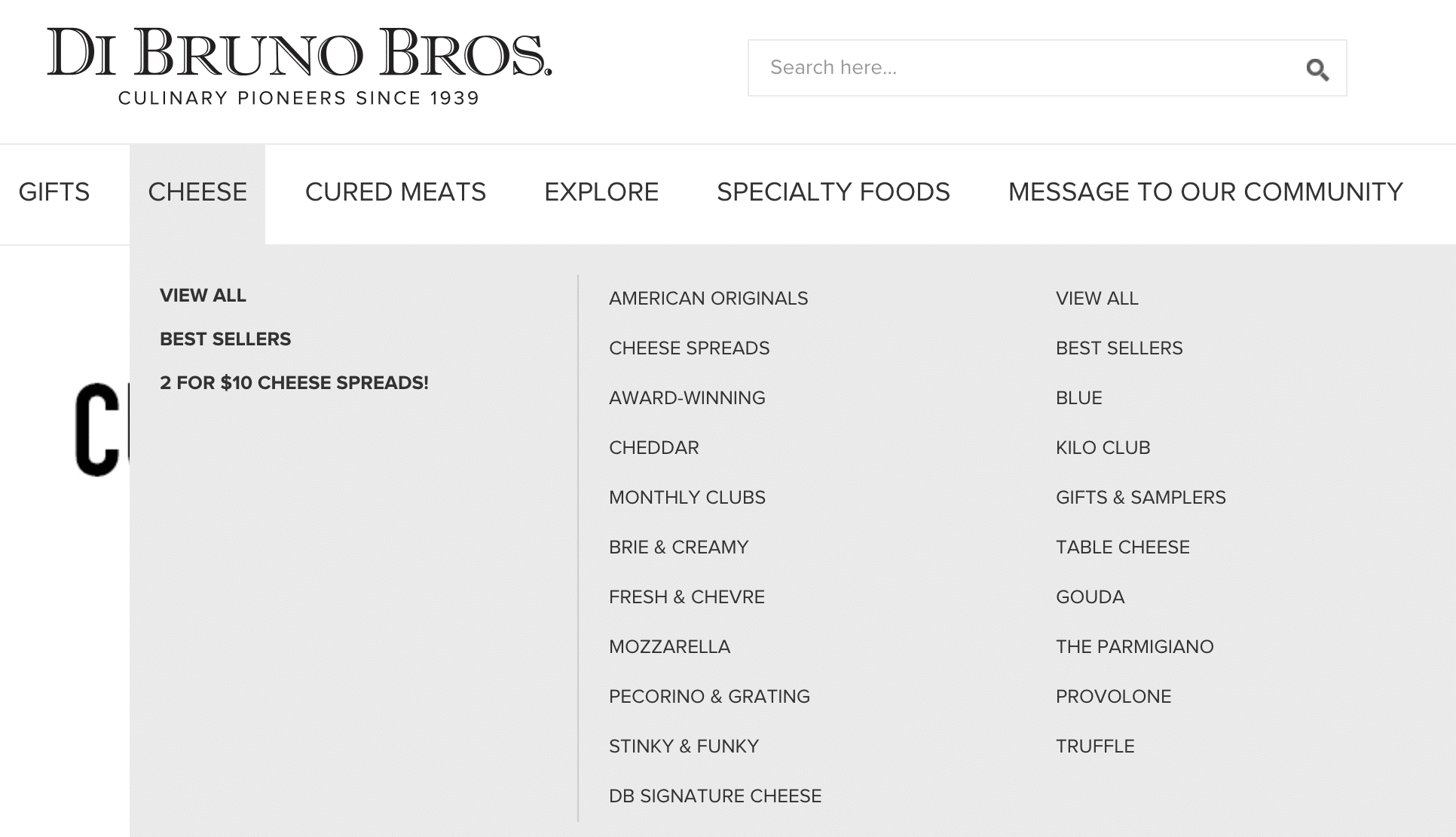
Product categories, including cheese, cured meats, and specialty foods, are found along the top of the home screen. Once the customer chooses, for example, the “Stinky & Funky” cheese category, they have filter and search options to continue narrowing down their selection.
The company caters to people looking for something tasty, even if they’re not sure what they’re looking for. The Explore category has options like BBQ Time, Top 10 Bestsellers, and From Philly With Love, providing curated suggestions for undecided buyers. This makes customers feel like they’re getting the same culinary inspiration and advice that they would in the store.
6. Optimize for mobile.
There are more than 275 million smartphones in the United States, and research by Google shows that the number of purchases made on mobiles is growing. In the past, people did research on their phones and bought products either in store or on a computer, but increasingly, customers want to be able to purchase as soon as they make a decision.
This is good for businesses, as fewer steps between finding a product and paying for it mean that the customer is more likely to complete the purchase. It’s the business’s job to decrease the steps for mobile customers and make sure their experience is as effortless as possible.
Mobile optimization refers to building a website specifically for a mobile device. Rather than just shrinking and slightly rearranging features, an optimized website has images, buttons, and fields that are clear and easy to click on, even when viewed on a small screen.
Some of the key features of an optimized site include large buttons, smaller images, auto-filled forms, and a guest checkout option. Also, consider using multiple pages rather than asking users to endlessly scroll to find a product.
Mobile optimization also gives you options for enhancing the ecommerce customer experience. Phones have location settings that can detect where a user is situated. If they want to buy online and pick up in the store, it’s easy to give them directions to the nearest location. As many people use their mobile devices to scroll through social media, make sure you include pathways for them to purchase from your social media accounts as well.
You can also add a click-to-call button on your page. This gives shoppers an easy way to reach customer support and ask questions or have an issue resolved. Lastly, don’t forget that pop-ups that can be ignored or removed on a desktop may cover all the content on a mobile page. If you must use them, make sure the dismiss button can be seen on a mobile screen.
7. Build unique product pages.
Product pages are a powerful way to stand out from the competition. Make them interesting and reflective of your brand, and people are more likely to stay on the page. Your customers want to see your brand’s personality, and the product page is the ideal place to show it off.
Your product pages should be useful as well. Your customer is looking for the information they need to make a purchasing decision, so don’t make them search. Make it clear what your product is and how it’s superior to others on the market. The page should show the customer why your item is the perfect choice.
Burrow sells furniture online, which can be difficult as customers want to feel the materials, sit in the chairs, and get an idea of how the piece functions. Burrow rises to the challenge with their unique product pages that give customers an abundance of information.
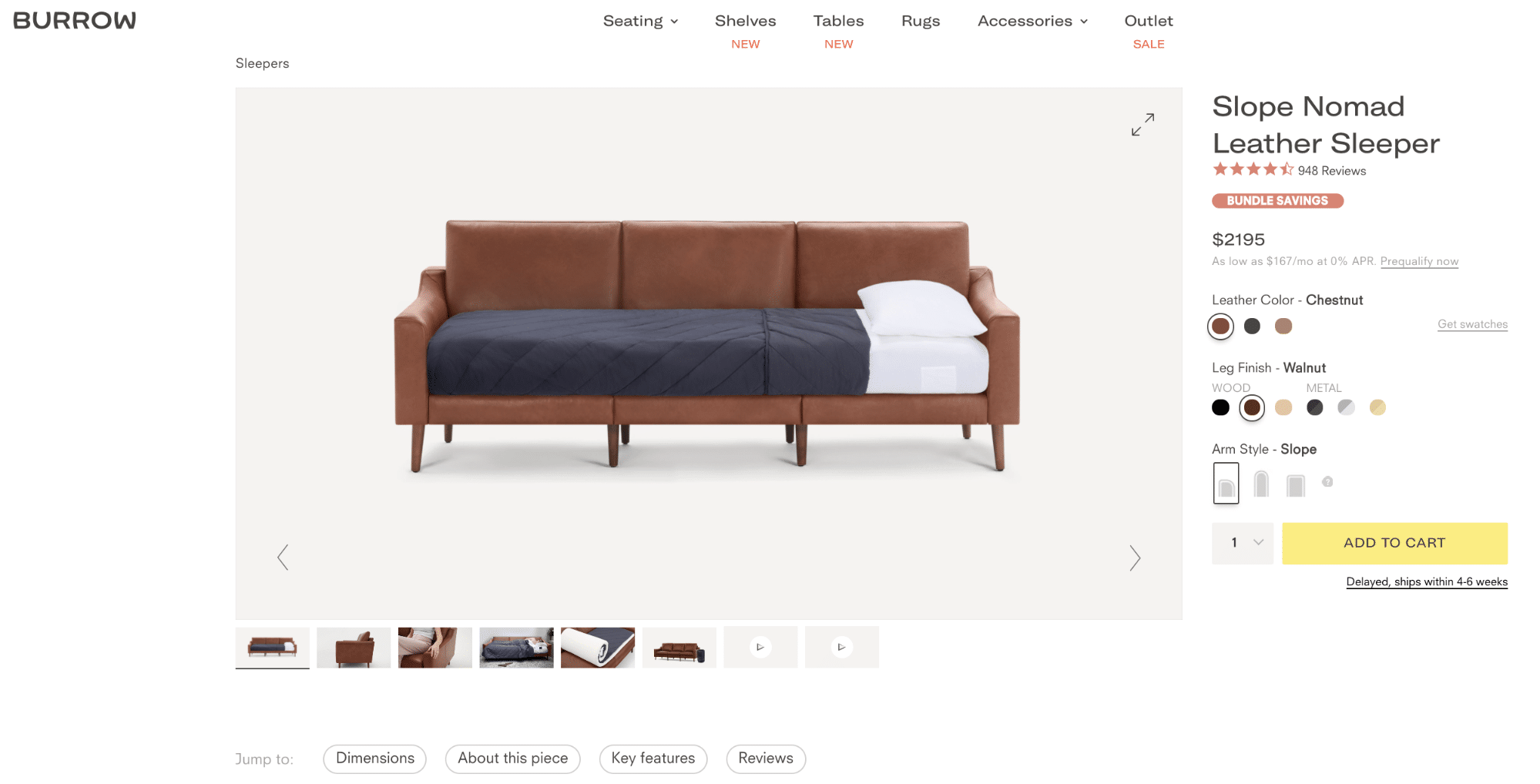
The dimensions and materials of each piece are clearly stated to give customers an idea of how it might fit in their space. Additionally, Burrow uses GIFs to show customers both how the piece is put together and how it functions. For example, their Bento Coffee Table has storage and removable trays, and an animation shows the different ways the trays can be arranged to create a unique furnishing solution.
8. Include customer reviews.
“When you say it, it’s marketing. When your customer says it, it’s social proof.” – Andy Crestodina
When customers can’t see and touch a product in person, they rely on the experience of other consumers to give them an idea of the product’s quality and usefulness. Research shows that nearly 95% of shoppers read reviews before making a purchase. Additionally, products with reviews are 270% more likely to be purchased than those without. Simply put, reviews build credibility and show the customer that the product will do what it says.
Including reviews on your product page has two benefits. First, it means customers don’t need to click away from your page to find the information they’re looking for. More importantly, it shows them that you stand behind your product enough to publish what past customers are saying. This builds a customer’s trust in the business and makes them more likely to purchase.
Reviews also increase customer engagement with your brand. If you reach out to purchasers for their opinions, you get feedback about the product and their experience, which allows you to make improvements. It also keeps the product in your customers’ minds.
Cosmetics are one of those products that many consumers like to try before purchasing. Bliss World’s reviews include the reviewer’s skin type, gender, and age, so people reading the reviews can get an idea of how the product works for similar buyers.
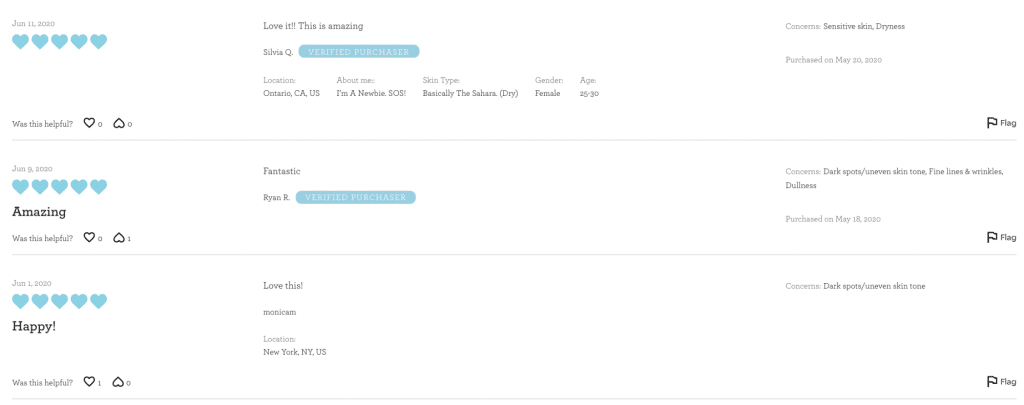
They even include location information since climate impacts skin health.
9. Provide an end-to-end experience.
Finally, remember that the digital ecommerce customer experience doesn’t end with the purchase. It doesn’t even end online. If your customer has a poor experience after they hit that glimmering “Buy” button, it will still reflect poorly on the business and its brand, so make sure you use every opportunity to create a great end-to-end customer experience.
As far as online experiences are concerned, use your thank-you screen to add value for the customer. You can do this by showing off the brand’s sense of humor and personality or by offering a voucher for their next purchase. You can also include videos that show buyers how to use their new purchase, accessorize the product, and more.
Your receipt and delivery emails are another great way to improve the ecommerce customer experience. Remember, you want to train people to open your emails, so move beyond the boring and generic. For custom products, some insight into how they’re made can be fascinating while giving the buyer an idea of how long delivery will take.
Again, any opportunity to share your brand’s personality helps build a connection with customers. Consider product packaging. Make unboxing the product a memorable experience, and help customers go from buyers to brand ambassadors. Build a community of shoppers who share information on new ways to style your clothes or use your planner. With the right approach, you’ll find that people will do a large part of your marketing for you.
Don’t forget the practicalities. A great digital experience can be ruined by long delivery times or shipping damage. Make sure customer support is available to answer questions or to resolve any issues that arise once your buyer receives their purchase.
Conclusion
Many factors are involved in building and growing a successful business, and it’s sometimes hard to know where to focus. To enjoy the rewards, creating a good ecommerce customer experience needs to be at the forefront of every digital business strategy.
Companies that provide a good ecommerce customer experience move beyond discounts and free shipping. They use every customer interaction as an opportunity to build a relationship. A customer-focused design backed by the right technology can turn casual shoppers into loyal followers, which is a win for everyone.
Originally published Mar 01, 2020, updated Jul 25, 2024


